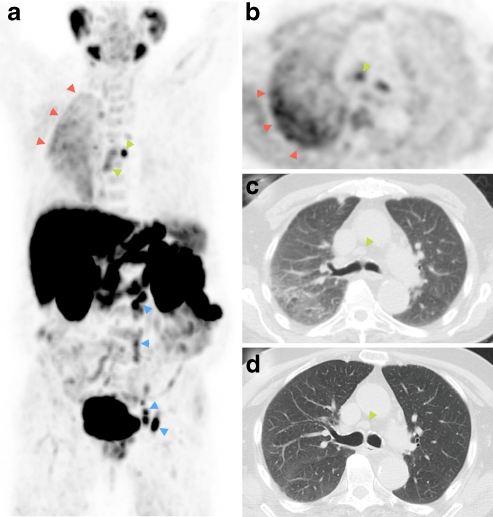18F-Methylcholine (FCH) is a marker of proliferation that can be used for the detection and (re)staging of prostate cancer [1, 2]. A 78-year-old male with T3G3 prostate cancer (PSA 47 μg/l, nadir PSA 2.2 μg/l with LHRH treatment) and rising PSA (4.8 μg/l) was referred for restaging with FCH PET/CT. Images obtained 30 minutes after injection (a, b) demonstrated choline-avid nodal metastases in the left parailiac and paraaortal regions (blue arrowheads). In addition, the upper lobe of the right lung showed diffuse FCH uptake with SUVmean 3.0 (red arrowheads) and diffuse infiltration on low-dose CT (c). Several enlarged mediastinal lymph nodes showed uptake as well (green arrowheads). Pulmonary infection with reactive nodes was suspected, but we were unable to discriminate them from mediastinal prostate cancer metastases.

In retrospect, the patient had been coughing for several weeks but had no other symptoms. Bronchial lavage revealed legionellosis. After 3 weeks treatment with ciprofloxacin the pulmonary infiltration had disappeared completely on the CT scan (d), confirming the inflammatory origin of the choline uptake. However, the enlarged mediastinal lymph nodes persisted. No further investigations of the mediastinum were performed because of the age and prognosis of the patient, and the origin of the enlarged nodes remained uncertain.
As previously suggested by animal experiments [3], active infection can be choline-avid. Our case demonstrates that this can even occur in a diffuse and clinically indolent infection. We conclude that, as in FDG PET imaging, when active infection is suspected, adequate antimicrobial treatment should precede FCH PET/CT to avoid compromised imaging of oncological disease.
Acknowledgments
Open Access
This article is distributed under the terms of the Creative Commons Attribution Noncommercial License which permits any noncommercial use, distribution, and reproduction in any medium, provided the original author(s) and source are credited.
References
- 1.Igerc I, Kohlfürst S, Gallowitsch HJ, Matschnig S, Kresnik E, Gomez-Segovia I, et al. The value of 18F-choline PET/CT in patients with elevated PSA-level and negative prostate needle biopsy for localization of prostate cancer. Eur J Nucl Med Mol Imaging. 2008;35:976–983. doi: 10.1007/s00259-007-0686-9. [DOI] [PubMed] [Google Scholar]
- 2.Heinisch M, Dirisamer A, Loidl W, Stoiber F, Gruy B, Haim S, et al. Positron emission tomography/computed tomography with F-18-fluorocholine for restaging of prostate cancer patients: meaningful at PSA < 5 ng/ml? Mol Imaging Biol. 2006;8:43–48. doi: 10.1007/s11307-005-0023-2. [DOI] [PubMed] [Google Scholar]
- 3.Wyss MT, Weber B, Honer M, Späth N, Ametamey SM, Westera G, et al. 18F-choline in experimental soft tissue infection assessed with autoradiography and high-resolution PET. Eur J Nucl Med Mol Imaging. 2004;31:312–316. doi: 10.1007/s00259-003-1337-4. [DOI] [PubMed] [Google Scholar]


